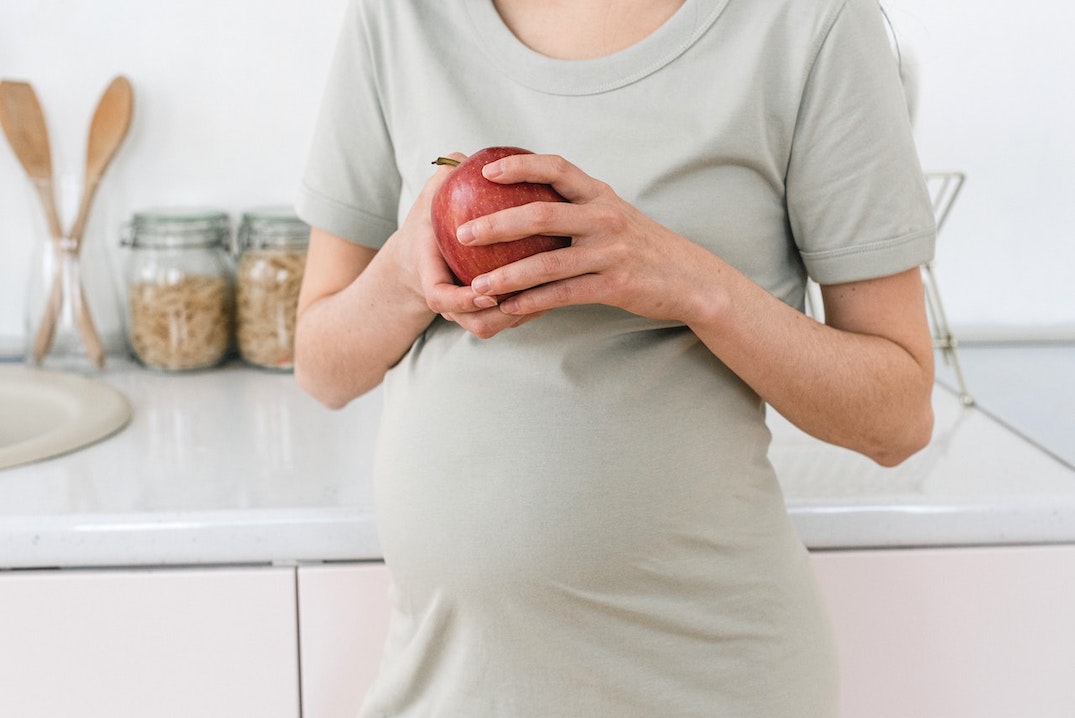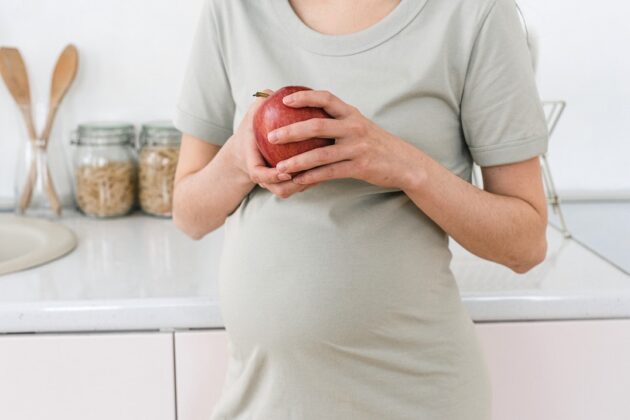Third Trimester Nausea & Morning Sickness: Causes & Treatment
Morning sickness is a natural part of being pregnant. Few women go without it in the first few months of pregnancy. And while it’s called “morning sickness,” this symptom can occur at any time of the day.
Nausea after eating is common early in pregnancy. It generally begins as soon as the pregnancy hormones surge and peaks at six to 10 weeks of gestation (about two to six weeks after you have a positive pregnancy test). These symptoms pass for most women around 14 to 20 weeks of gestation, giving them plenty of time to eat normally and feel well.
In a few cases, however, morning sickness or “nausea and vomiting of pregnancy” (NVP) persists into the third trimester. If you’re still having nausea and vomiting in the third trimester, you might be worried about whether this is normal.
This guide covers the different reasons for persistent nausea and vomiting in the third trimester. You’ll learn that some explanations are completely harmless, while others mean you need to see your doctor. Finally, you’ll learn ways to soothe your nausea so you can better prepare for the new arrival to your family.

Healthy mom, healthy baby: Get support from a prenatal dietitian
90% of Zaya Care patients pay $0 for one-on-one counseling with a Registered Dietitan
What causes nausea in the third trimester of pregnancy?
Like heartburn and acid reflux during pregnancy, nausea and vomiting in the third trimester can be the persistence of symptoms you’ve had throughout your pregnancy. It may also be a new symptom you didn’t have before, even in the first trimester.
Finally, you may have recovered from morning sickness but, after weeks of relief, your symptoms return.
Let’s go over the various causes of nausea or vomiting in the third trimester:
- Hormonal issues. Pregnancy hormones, particularly human chorionic gonadotropin, estrogen, and progesterone, tend to cause nausea in some women. In cases of a disorder called hyperemesis gravidarum, you have excessive nausea and often higher than normal hormone levels. Hyperemesis can persist into the third trimester.
- Your changing body. Nausea and vomiting can happen simply by the added pressure of the growing baby on your internal organs. If the uterus is pressed up against the stomach or diaphragm, you can have excess nausea you wouldn’t have earlier in your pregnancy.
- Preeclampsia. Preeclampsia is a condition of high blood pressure, swelling, and protein loss through the kidneys. Nausea and vomiting, along with upper abdominal pain, can occur as part of this syndrome.
- HELLP syndrome. The most advanced cases of preeclampsia can lead to HELLP syndrome, which involves preeclampsia and severe liver inflammation, low platelets, and blood cell breakdown. You are likely to have nausea and vomiting with this disorder. A few cases of HELLP syndrome arise without having preeclampsia.
- AFLP. This disorder, acute fatty liver of pregnancy, involves a buildup of fat in the liver brought on by pregnancy in those who have a genetic tendency for fatty liver disease and other risk factors. Symptoms of anorexia, nausea, and vomiting are common.
- Dietary factors. Your diet may matter in developing nausea and vomiting during the third trimester. Greasy foods, spices, and large meals can contribute to feeling nauseous at any point during your pregnancy.
- Medical issues. If you have underlying health problems, including Crohn’s disease, gastroparesis, or inflammatory bowel disease, you can have excessive nausea, vomiting, and bloating while pregnant, even if you didn’t have issues prior to becoming pregnant.
- Infections. Helicobacter pylori is a type of bacterial infection. You may have this bacterium in your GI tract and have no symptoms, but it can contribute to stomach upset.
>> Read more: Lack of appetite during pregnancy—causes & solutions
When nausea in the third trimester may be a sign of labor
Nausea can be an early sign of labor. When you go into labor, your stomach tends to shut down in preparation for the process. If you recently had a large meal and then went into labor, nausea might ensue as one of the first signs that labor has begun.
Fortunately, nausea isn’t often an early sign of labor, nor is it the only one. More reliable signs that you may be in labor, include the following:
- Lightening. This is when the baby settles in the birth canal, relieving some of the pressure from the uterus sitting up under the diaphragm.
- Back pain. Early labor pains often feel like back pain as the uterus begins to tighten, irregularly at first.
- Loss of the mucus plug. This happens when the cervix begins to dilate. The mucus plug has been inside the cervix throughout pregnancy to prevent infection from getting into the uterus; when the cervix shortens or dilates, the plug is lost.
- Amniotic fluid leakage. The amniotic fluid surrounds the baby. During labor or just prior, this fluid will gush out or leak slowly.
- Diarrhea. The sudden reduction in some pregnancy hormones, mainly progesterone, can lead to natural diarrhea prior to labor onset.
- Increased regularity of contractions. Labor differs from Braxton-Hicks contractions by the strength and regularity of the contractions.
When to seek medical attention for nausea in the third trimester
You should always try to eat the best foods when pregnant for your baby’s development. You are also trying to get the right amount of calories for your stage of pregnancy.
Both of these can be difficult if your nausea and/or vomiting persists into or begins in the third trimester. Some situations are normal, transient, and nothing to be concerned about, but it’s always a good idea to talk to your doctor about your concerns.
Nausea in the third trimester carries more significance and is something you definitely want to see your doctor about if you also have these symptoms:
- Signs of preeclampsia. If you have nausea linked to preeclampsia (which is a common symptom), you may notice upper abdominal pain, hand or face swelling, blurry vision, headache, seeing spots before your eyes, sudden weight gain, or irritability.
- Signs of HELLP. HELLP may come from preeclampsia. Besides nausea and the symptoms of preeclampsia, you may notice bruising from low platelets, or upper right-side abdominal pain.
- Signs of AFLP. With this disorder, you might also notice bleeding or bruising from an inability to properly clot blood. The symptoms you see in HELLP and preeclampsia are also seen in AFLP. There is a greater likelihood of bleeding in AFLP than with HELLP.
- Signs of dehydration. When you have nausea and vomiting, you risk dehydration from low fluid volume. Signs of dehydration include thirst, rapid heartbeat, dark urine, and reduced urine volume.
If you have these symptoms or are concerned you have something more than minor nausea, you should seek medical attention. Even if it turns out to be nothing, you’ll feel reassured that you and your baby are fine.

Healthy mom, healthy baby: Get support from a prenatal dietitian
90% of Zaya Care patients pay $0 for one-on-one counseling with a Registered Dietitan
Medication options for nausea during pregnancy
In some cases, medications are recommended or prescribed by your doctor to help with nausea during the third trimester of pregnancy.
You may not need medication for very long; however, having some on hand or taking it to avoid becoming dehydrated or having insufficient nutrient intake might be a good idea.
Some medications that may help:
- Antihistamines. This includes meclizine, Dramamine, and Benadryl. They act on the vomiting centers of the brain to reduce nausea and block the urge to vomit. Scopolamine patches often used for seasickness have a similar effect simply by placing a patch on the skin.
- Phenothiazines. These include chlorpromazine, promethazine, and prochlorperazine used to manage nausea by blocking certain receptors in the brain. They are not recommended for every woman (particularly in the first trimester) but later in pregnancy, no major risks are seen.
- Promotility drugs. This includes metoclopramide, used to move food more quickly through the stomach and prevent it from backing up into the esophagus.
- Zofran. This is a drug used for severe nausea and vomiting. It acts on the gut and brain to reduce the urge to vomit and is generally considered safe.
Tips for soothing nausea late in pregnancy
If you don’t want or need to take medications for nausea or morning sickness in the third trimester of pregnancy, consider trying one or more home remedies to reduce your symptoms. Home remedies often have centuries of experience among women without any known adverse effects.
Let’s look at your options and see why they help reduce nausea in pregnancy:
- Eat several small meals daily. A full stomach often contributes to nausea in pregnancy. If you eat smaller meals, you will have less fullness in your stomach at one time.
- Avoid excessive fat in the diet. Fatty foods cause slowing of the GI tract. The stomach contents remain for longer, resulting in a greater chance of developing nausea and vomiting. Foods that cause gas (beans, high-fiber vegetables, and whole grains) may also cause stomach upset.
- Try ginger. Ginger has been used for centuries to reduce nausea. You can use ginger extracts or ginger root (in your food). It stimulates saliva and bile flow, enhancing digestion and GI motility. Many women find it very helpful for routine use.
- Use acupressure or acupuncture. Acupressure-based wristbands are used to reduce nausea with moderate effectiveness. Acupuncture can also help reduce nausea, although the exact way it works isn’t known. You can learn more about the benefits of acupuncture during pregnancy here.
- Add thiamine. You can take thiamine supplements or consume foods high in this vitamin (Vitamin B6) to reduce symptoms of nausea safely.
Working with a prenatal nutritionist is a great way to get support for this issue. They have years of training and know how to manage even the most complex pregnancy-related nutritional issues.
Here at Zaya Care, we make finding a prenatal nutritionist easy. You can use our search tool to find a provider that fits your needs. Our platform connects you with the right nutritionist based on your needs, preferences, and insurance, and you can easily book your online or in-person visit at a time that’s convenient for you.
Morning sickness is a natural part of being pregnant. Few women go without it in the first few months of pregnancy. And while it’s called “morning sickness,” this symptom can occur at any time of the day.
Nausea after eating is common early in pregnancy. It generally begins as soon as the pregnancy hormones surge and peaks at six to 10 weeks of gestation (about two to six weeks after you have a positive pregnancy test). These symptoms pass for most women around 14 to 20 weeks of gestation, giving them plenty of time to eat normally and feel well.
In a few cases, however, morning sickness or “nausea and vomiting of pregnancy” (NVP) persists into the third trimester. If you’re still having nausea and vomiting in the third trimester, you might be worried about whether this is normal.
This guide covers the different reasons for persistent nausea and vomiting in the third trimester. You’ll learn that some explanations are completely harmless, while others mean you need to see your doctor. Finally, you’ll learn ways to soothe your nausea so you can better prepare for the new arrival to your family.

Healthy mom, healthy baby: Get support from a prenatal dietitian
90% of Zaya Care patients pay $0 for one-on-one counseling with a Registered Dietitan
What causes nausea in the third trimester of pregnancy?
Like heartburn and acid reflux during pregnancy, nausea and vomiting in the third trimester can be the persistence of symptoms you’ve had throughout your pregnancy. It may also be a new symptom you didn’t have before, even in the first trimester.
Finally, you may have recovered from morning sickness but, after weeks of relief, your symptoms return.
Let’s go over the various causes of nausea or vomiting in the third trimester:
- Hormonal issues. Pregnancy hormones, particularly human chorionic gonadotropin, estrogen, and progesterone, tend to cause nausea in some women. In cases of a disorder called hyperemesis gravidarum, you have excessive nausea and often higher than normal hormone levels. Hyperemesis can persist into the third trimester.
- Your changing body. Nausea and vomiting can happen simply by the added pressure of the growing baby on your internal organs. If the uterus is pressed up against the stomach or diaphragm, you can have excess nausea you wouldn’t have earlier in your pregnancy.
- Preeclampsia. Preeclampsia is a condition of high blood pressure, swelling, and protein loss through the kidneys. Nausea and vomiting, along with upper abdominal pain, can occur as part of this syndrome.
- HELLP syndrome. The most advanced cases of preeclampsia can lead to HELLP syndrome, which involves preeclampsia and severe liver inflammation, low platelets, and blood cell breakdown. You are likely to have nausea and vomiting with this disorder. A few cases of HELLP syndrome arise without having preeclampsia.
- AFLP. This disorder, acute fatty liver of pregnancy, involves a buildup of fat in the liver brought on by pregnancy in those who have a genetic tendency for fatty liver disease and other risk factors. Symptoms of anorexia, nausea, and vomiting are common.
- Dietary factors. Your diet may matter in developing nausea and vomiting during the third trimester. Greasy foods, spices, and large meals can contribute to feeling nauseous at any point during your pregnancy.
- Medical issues. If you have underlying health problems, including Crohn’s disease, gastroparesis, or inflammatory bowel disease, you can have excessive nausea, vomiting, and bloating while pregnant, even if you didn’t have issues prior to becoming pregnant.
- Infections. Helicobacter pylori is a type of bacterial infection. You may have this bacterium in your GI tract and have no symptoms, but it can contribute to stomach upset.
>> Read more: Lack of appetite during pregnancy—causes & solutions
When nausea in the third trimester may be a sign of labor
Nausea can be an early sign of labor. When you go into labor, your stomach tends to shut down in preparation for the process. If you recently had a large meal and then went into labor, nausea might ensue as one of the first signs that labor has begun.
Fortunately, nausea isn’t often an early sign of labor, nor is it the only one. More reliable signs that you may be in labor, include the following:
- Lightening. This is when the baby settles in the birth canal, relieving some of the pressure from the uterus sitting up under the diaphragm.
- Back pain. Early labor pains often feel like back pain as the uterus begins to tighten, irregularly at first.
- Loss of the mucus plug. This happens when the cervix begins to dilate. The mucus plug has been inside the cervix throughout pregnancy to prevent infection from getting into the uterus; when the cervix shortens or dilates, the plug is lost.
- Amniotic fluid leakage. The amniotic fluid surrounds the baby. During labor or just prior, this fluid will gush out or leak slowly.
- Diarrhea. The sudden reduction in some pregnancy hormones, mainly progesterone, can lead to natural diarrhea prior to labor onset.
- Increased regularity of contractions. Labor differs from Braxton-Hicks contractions by the strength and regularity of the contractions.
When to seek medical attention for nausea in the third trimester
You should always try to eat the best foods when pregnant for your baby’s development. You are also trying to get the right amount of calories for your stage of pregnancy.
Both of these can be difficult if your nausea and/or vomiting persists into or begins in the third trimester. Some situations are normal, transient, and nothing to be concerned about, but it’s always a good idea to talk to your doctor about your concerns.
Nausea in the third trimester carries more significance and is something you definitely want to see your doctor about if you also have these symptoms:
- Signs of preeclampsia. If you have nausea linked to preeclampsia (which is a common symptom), you may notice upper abdominal pain, hand or face swelling, blurry vision, headache, seeing spots before your eyes, sudden weight gain, or irritability.
- Signs of HELLP. HELLP may come from preeclampsia. Besides nausea and the symptoms of preeclampsia, you may notice bruising from low platelets, or upper right-side abdominal pain.
- Signs of AFLP. With this disorder, you might also notice bleeding or bruising from an inability to properly clot blood. The symptoms you see in HELLP and preeclampsia are also seen in AFLP. There is a greater likelihood of bleeding in AFLP than with HELLP.
- Signs of dehydration. When you have nausea and vomiting, you risk dehydration from low fluid volume. Signs of dehydration include thirst, rapid heartbeat, dark urine, and reduced urine volume.
If you have these symptoms or are concerned you have something more than minor nausea, you should seek medical attention. Even if it turns out to be nothing, you’ll feel reassured that you and your baby are fine.

Healthy mom, healthy baby: Get support from a prenatal dietitian
90% of Zaya Care patients pay $0 for one-on-one counseling with a Registered Dietitan
Medication options for nausea during pregnancy
In some cases, medications are recommended or prescribed by your doctor to help with nausea during the third trimester of pregnancy.
You may not need medication for very long; however, having some on hand or taking it to avoid becoming dehydrated or having insufficient nutrient intake might be a good idea.
Some medications that may help:
- Antihistamines. This includes meclizine, Dramamine, and Benadryl. They act on the vomiting centers of the brain to reduce nausea and block the urge to vomit. Scopolamine patches often used for seasickness have a similar effect simply by placing a patch on the skin.
- Phenothiazines. These include chlorpromazine, promethazine, and prochlorperazine used to manage nausea by blocking certain receptors in the brain. They are not recommended for every woman (particularly in the first trimester) but later in pregnancy, no major risks are seen.
- Promotility drugs. This includes metoclopramide, used to move food more quickly through the stomach and prevent it from backing up into the esophagus.
- Zofran. This is a drug used for severe nausea and vomiting. It acts on the gut and brain to reduce the urge to vomit and is generally considered safe.
Tips for soothing nausea late in pregnancy
If you don’t want or need to take medications for nausea or morning sickness in the third trimester of pregnancy, consider trying one or more home remedies to reduce your symptoms. Home remedies often have centuries of experience among women without any known adverse effects.
Let’s look at your options and see why they help reduce nausea in pregnancy:
- Eat several small meals daily. A full stomach often contributes to nausea in pregnancy. If you eat smaller meals, you will have less fullness in your stomach at one time.
- Avoid excessive fat in the diet. Fatty foods cause slowing of the GI tract. The stomach contents remain for longer, resulting in a greater chance of developing nausea and vomiting. Foods that cause gas (beans, high-fiber vegetables, and whole grains) may also cause stomach upset.
- Try ginger. Ginger has been used for centuries to reduce nausea. You can use ginger extracts or ginger root (in your food). It stimulates saliva and bile flow, enhancing digestion and GI motility. Many women find it very helpful for routine use.
- Use acupressure or acupuncture. Acupressure-based wristbands are used to reduce nausea with moderate effectiveness. Acupuncture can also help reduce nausea, although the exact way it works isn’t known. You can learn more about the benefits of acupuncture during pregnancy here.
- Add thiamine. You can take thiamine supplements or consume foods high in this vitamin (Vitamin B6) to reduce symptoms of nausea safely.
Working with a prenatal nutritionist is a great way to get support for this issue. They have years of training and know how to manage even the most complex pregnancy-related nutritional issues.
Here at Zaya Care, we make finding a prenatal nutritionist easy. You can use our search tool to find a provider that fits your needs. Our platform connects you with the right nutritionist based on your needs, preferences, and insurance, and you can easily book your online or in-person visit at a time that’s convenient for you.
















